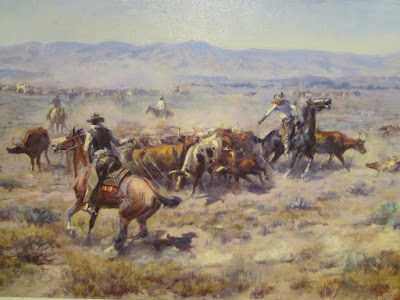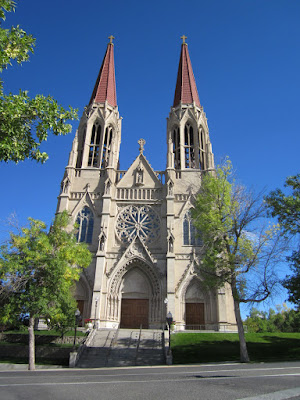We decided to spend the week prior to the Labor Day holiday on the eastern slope of the Cascade Range. We checked into Wenatchee River County Park on September 30 for a week. This well maintained and peaceful park is very RV friendly with full hookups and 50 amp service at each paved site. This area is in the rain shadow of the mountains and receives very little rain. The Wenatchee River converges with the mighty Columbia River providing plenty of water for irrigation of orchards as well as hydro-electric power.
 |
| Our site at Wenatchee River County Park |
Leavenworth, a German Town
Fifteen miles west of the RV Park is the quaint German town of Leavenworth. This popular tourist town is full of restaurants with authentic German cuisine, beer gardens, bakeries and interesting gift stores. We partook at a couple of the establishments, eating brauts, sauerkraut, sauerbraten, weinersnitzel, spatzle and apple strudel and other assorted things we can't pronounce and don't remember their name.
 |
ALL the buildings in the town are
Bavarian style, even McDonalds. |
 |
| The streets were dressed in beautiful flowers. |
LIBERTY ORCHARDS MAKERS OF APLETS & COTLETS, Cashmere, Washington
We love taking tours, especially of candy factories. Liberty Orchards, produces Washington's take on Turkish Delight, since 1920. Aplets & Cotlets are small, gelatin-like confections baked in powdered-sugar around walnuts.
 |
| Donning hairnets for our tour after checking out the samples. |
 |
| Packing for the Christmas Rush |
STUTZMAN RANCH
We found this pick your own orchard, just one mile from our home. The fruit was fresh and extremely well priced. We picked two buckets of Gala apples along with Bartlett pears and Hale peaches. Couldn't help but go there twice.
 |
| This orchard had at least four different kinds of apples. |
 |
| Didn't take long to fill our buckets. |
 |
| We fed a reject to the goats. |
 |
Orondo Cider Works
We had fresh pressed cider and homemade apple
cider donuts for lunch one day. |
 |
As Carl Sagen would say, there are billions and billions
of apples along the Columbia River Valley. |
 |
| Virginia's Homemade Apple Pie and Apple Sauce |
DAMS ALONG THE COLUMBIA
If there is one thing the Columbia River Valley has, besides fruit orchards, its hydro-electric dams. We visited three of the biggest and took two tours.
 |
Chief Joseph Dam, near Chelan
Second Largest Hydro-Electric Producing Dam
in North America |
 |
Grand Coulee Dam
Largest Hydro-Electric Producing Dam
in North America |
 |
Rocky Reach Dam
A "Z" Shaped Hydro-Electric Dam
had the best tour of the three. |
 |
| Rocky Reach Fish Ladder |
 |
| Salmon Viewing Windows |
 |
| Turbine Power Generators |
DRY FALLS STATE PARK, COULEE CITY
Dry Falls, a long-extinct cascade would have dwarfed Niagara Falls. One especially large lake that covered a portion of northwest Montana broke through an ice dam in prehistoric times, unleashing a tremendous volume of water that rushed along forming the Grand Coulee and leaving behind the skeleton of the greatest waterfall in history. This three and a half mile wide falls that dropped 400 feet is now referred to as Dry Falls.































































